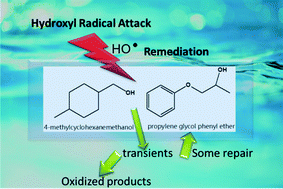Oxidative remediation of 4-methylcyclohexanemethanol (MCHM) and propylene glycol phenyl ether (PPh). Evidence of contaminant repair reaction pathways
Abstract
A large spill of 4-methylcyclohexanemethanol (MCHM) and propylene glycol phenyl ether (PPh) into the Elk River near Charleston, West Virginia on January 9, 2014 led to serious water contamination and public concerns about appropriate remediation. To assess the feasibility of advanced oxidation processes (AOPs) for remediation of waters contaminated with these compounds, we induced hydroxyl radical (HO˙) reactions using time-resolved and steady-state radiolysis methods. Detailed product analyses showed initial HO˙ attack was at the benzene ring of PPh, and occurred through H-atom abstraction reactions for MCHM. Pulse radiolysis and steady state radiolysis experiments conducted using pure compound solutions, mixtures of the compounds and real water solvents allowed us to obtain mechanistic insights of hydroxyl radical attack and establish the fate of the compounds using AOP remediation technologies. These results demonstrate that hydroxyl radical induced oxidization of PPh can lead to “repair-type” reactions, which regenerates this contaminant. The study further highlights the importance of such counterproductive reactions for the quantitative estimate of the required amount of oxidant in any large-scale treatment approaches.



 Please wait while we load your content...
Please wait while we load your content...